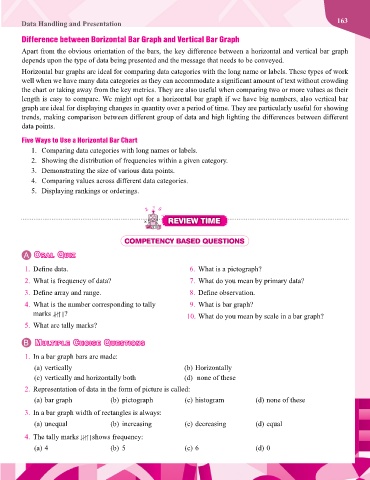Page 165 - Revised Maths Wisdom Class - 6
P. 165
Data Handling and Presentation 163
Difference between Borizontal Bar Graph and Vertical Bar Graph
Apart from the obvious orientation of the bars, the key difference between a horizontal and vertical bar graph
depends upon the type of data being presented and the message that needs to be conveyed.
Horizontal bar graphs are ideal for comparing data categories with the long name or labels. These types of work
well when we have many data categories as they can accommodate a significant amount of text without crowding
the chart or taking away from the key metrics. They are also useful when comparing two or more values as their
length is easy to compare. We might opt for a horizontal bar graph if we have big numbers, also vertical bar
graph are ideal for displaying changes in quantity over a period of time. They are particularly useful for showing
trends, making comparison between different group of data and high lighting the differences between different
data points.
Five Ways to Use a Horizontal Bar Chart
1. Comparing data categories with long names or labels.
2. Showing the distribution of frequencies within a given category.
3. Demonstrating the size of various data points.
4. Comparing values across different data categories.
5. Displaying rankings or orderings.
REVIEW TIMEEVIEW TIME
R
COMPETENCY BASED QUESTIONS
A Oral QuizOral Quiz
1. Define data. 6. What is a pictograph?
2. What is frequency of data? 7. What do you mean by primary data?
3. Define array and range. 8. Define observation.
4. What is the number corresponding to tally 9. What is bar graph?
marks ||? 10. What do you mean by scale in a bar graph?
5. What are tally marks?
B Multiple ChOiCe QuestiOns Multiple ChOiCe QuestiOns
1. In a bar graph bars are made:
(a) vertically (b) Horizontally
(c) vertically and horizontally both (d) none of these
2. Representation of data in the form of picture is called:
(a) bar graph (b) pictograph (c) histogram (d) none of these
3. In a bar graph width of rectangles is always:
(a) unequal (b) increasing (c) decreasing (d) equal
4. The tally marks shows frequency:
(a) 4 (b) 5 (c) 6 (d) 0

